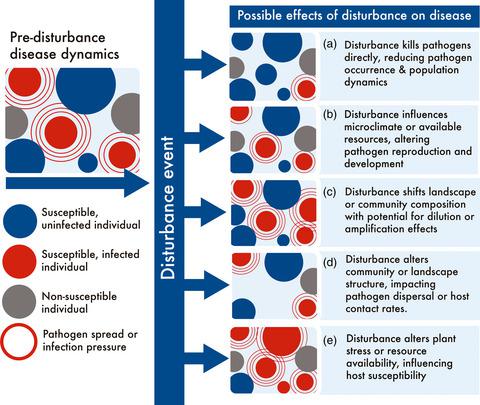Our official English website, www.x-mol.net, welcomes your feedback! (Note: you will need to create a separate account there.)
Wildfire alters the disturbance impacts of an emerging forest disease via changes to host occurrence and demographic structure
Journal of Ecology ( IF 5.5 ) Pub Date : 2020-08-16 , DOI: 10.1111/1365-2745.13495 Allison B. Simler‐Williamson 1, 2 , Margaret R. Metz 3 , Kerri M. Frangioso 1 , David M. Rizzo 1
中文翻译:

野火通过改变寄主的发生和人口结构来改变正在出现的森林疾病的干扰影响
更新日期:2020-08-16
Journal of Ecology ( IF 5.5 ) Pub Date : 2020-08-16 , DOI: 10.1111/1365-2745.13495 Allison B. Simler‐Williamson 1, 2 , Margaret R. Metz 3 , Kerri M. Frangioso 1 , David M. Rizzo 1
Affiliation

|
- Anthropogenic activities have altered historical disturbance regimes, and understanding the mechanisms by which these shifting perturbations interact is essential to predicting where they may erode ecosystem resilience. Emerging infectious plant diseases, caused by human translocation of nonnative pathogens, can generate ecologically damaging forms of novel biotic disturbance. Further, abiotic disturbances, such as wildfire, may influence the severity and extent of disease‐related perturbations via their effects on the occurrence of hosts, pathogens and microclimates; however, these interactions have rarely been examined.
- The disease ‘sudden oak death’ (SOD), associated with the introduced pathogen Phytophthora ramorum, causes acute, landscape‐scale tree mortality in California's fire‐prone coastal forests. Here, we examined interactions between wildfire and the biotic disturbance impacts of this emerging infectious disease. Leveraging long‐term datasets that describe wildfire occurrence and P. ramorum dynamics across the Big Sur region, we modelled the influence of recent and historical fires on epidemiological parameters, including pathogen presence, infestation intensity, reinvasion, and host mortality.
- Past wildfire altered disease dynamics and reduced SOD‐related mortality, indicating a negative interaction between these abiotic and biotic disturbances. Frequently burned forests were less likely to be invaded by P. ramorum, had lower incidence of host infection, and exhibited decreased disease‐related biotic disturbance, which was associated with reduced occurrence and density of epidemiologically significant hosts. Following a recent wildfire, survival of mature bay laurel, a key sporulating host, was the primary driver of P. ramorum infestation and reinvasion, but younger, rapidly regenerating host vegetation capable of sporulation did not measurably influence disease dynamics. Notably, the effect of P. ramorum infection on host mortality was reduced in recently burned areas, indicating that the loss of tall, mature host canopies may temporarily dampen pathogen transmission and ‘release’ susceptible species from significant inoculum pressure.
- Synthesis. Cumulatively, our findings indicate that fire history has contributed to heterogeneous patterns of biotic disturbance and disease‐related decline across this landscape, via changes to the both the occurrence of available hosts and the demography of epidemiologically important host populations. These results highlight that human‐altered abiotic disturbances may play a foundational role in structuring infectious disease dynamics, contributing to future outbreak emergence and driving biotic disturbance regimes.
中文翻译:

野火通过改变寄主的发生和人口结构来改变正在出现的森林疾病的干扰影响
- 人为活动已经改变了历史扰动机制,了解这些变化的扰动相互作用的机制对于预测它们可能侵蚀生态系统复原力的位置至关重要。由人类转移非本地病原体引起的新型传染性植物病害,可以产生新型生物干扰的生态破坏形式。此外,非生物干扰,例如野火,可能通过影响宿主,病原体和小气候的发生而影响与疾病有关的扰动的严重性和程度;但是,这些相互作用很少被检查。
- 与引入的病原菌疫霉菌相关的“突然橡树死亡”(SOD)病在加利福尼亚易火的沿海森林中导致景观水平的急性树木死亡。在这里,我们研究了野火与这种新兴传染病的生物干扰影响之间的相互作用。利用描述大苏尔地区野火发生和体育假单胞菌动态的长期数据集,我们对最近和历史大火对流行病学参数(包括病原体的存在,侵染强度,入侵和寄主死亡率)的影响进行了建模。
- 过去的野火改变了疾病动态并降低了与SOD相关的死亡率,表明这些非生物和生物干扰之间存在负向相互作用。经常烧毁的森林较少受到拉美假单胞菌的入侵,寄主感染的发生率较低,与疾病相关的生物干扰减少,这与流行病学上重要寄主的发生和密度降低有关。在最近的一场野火之后,主要的孢子寄主宿主成熟的月桂树的存活是拉美假单胞菌侵染和再入侵的主要驱动力,但是能够孢子形成的年轻,快速再生的寄主植物并没有显着影响疾病的动态。值得注意的是,P。ramorum的影响 在最近被烧毁的地区,宿主感染的死亡率降低了,这表明高大,成熟的宿主冠层的丧失可能会暂时抑制病原体的传播,并从明显的接种压力中“释放”易感物种。
- 综合。累积地,我们的发现表明,火灾史通过改变可用宿主的发生率和流行病学重要宿主种群的人口统计学,在整个景观中造成了生物干扰和疾病相关衰退的异质模式。这些结果表明,人为改变的非生物干扰可能在构建传染病动态中起基础作用,有助于未来爆发疫情并推动生物干扰机制。



























 京公网安备 11010802027423号
京公网安备 11010802027423号